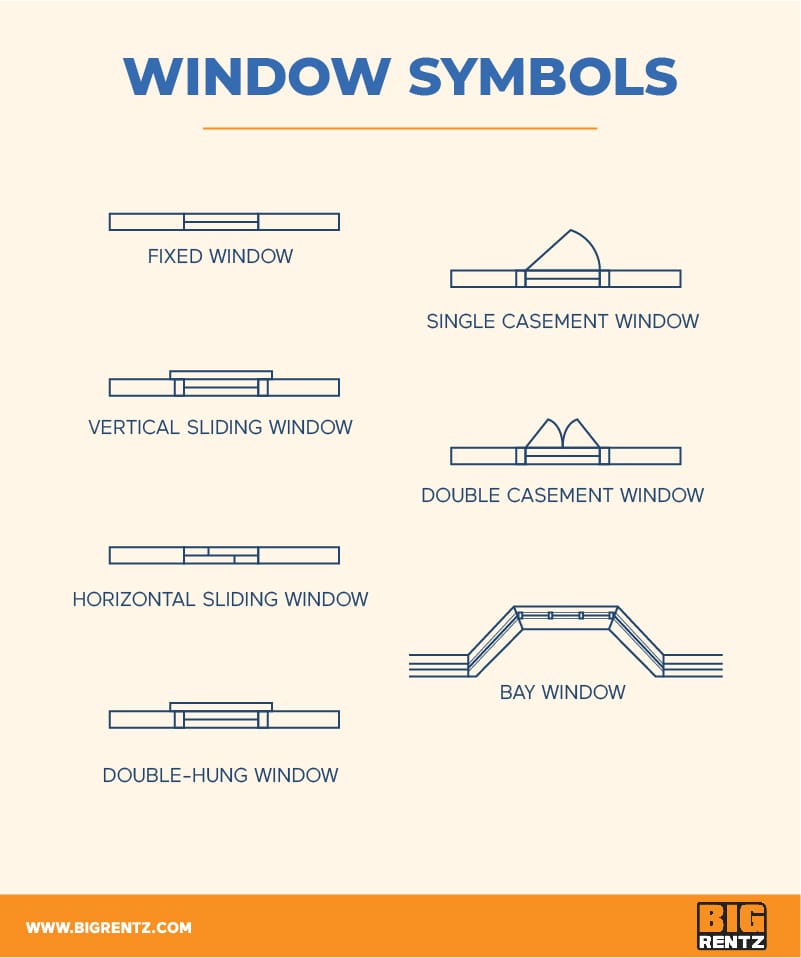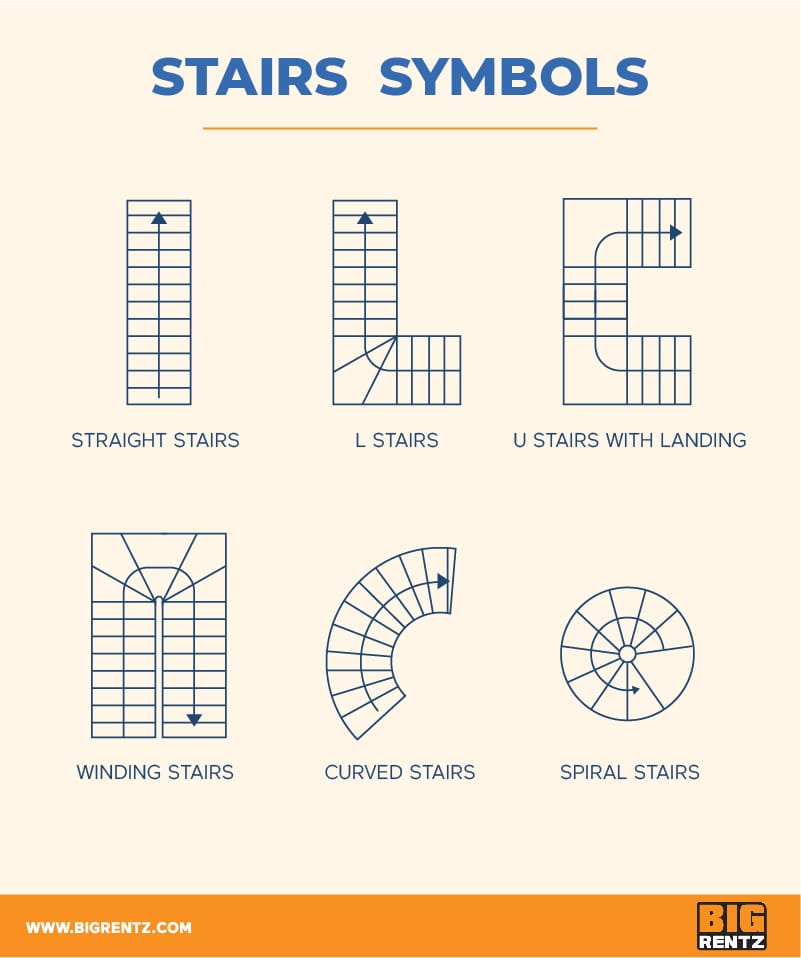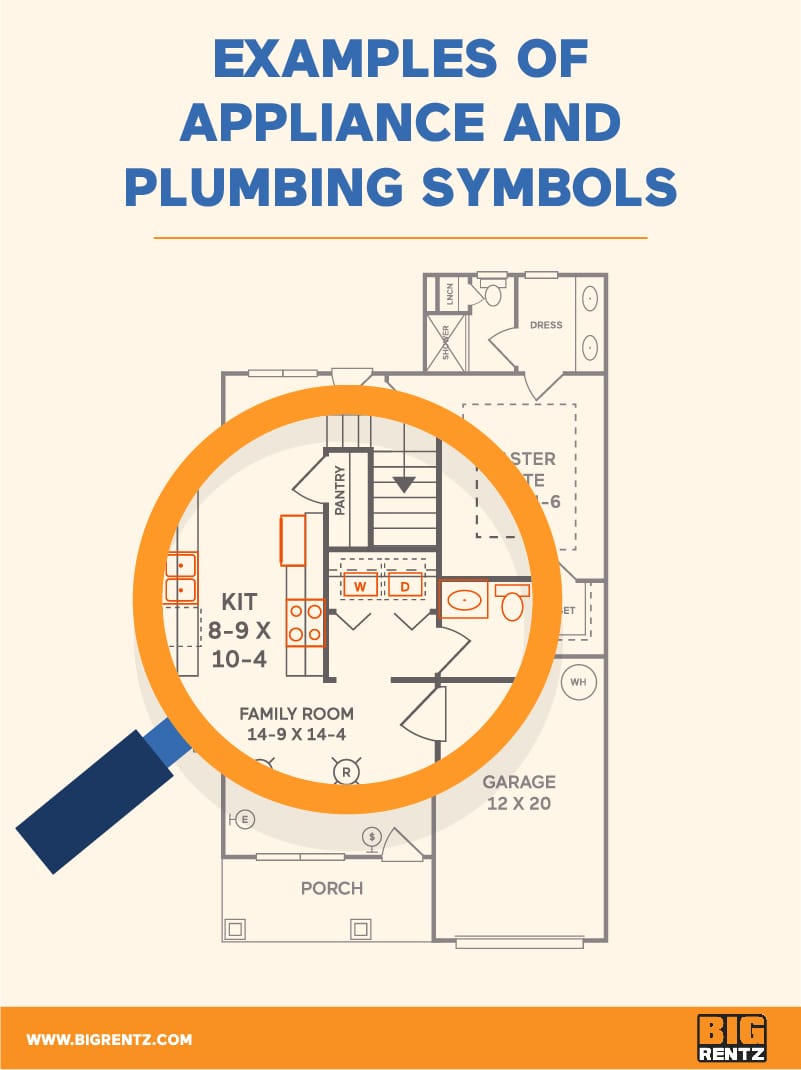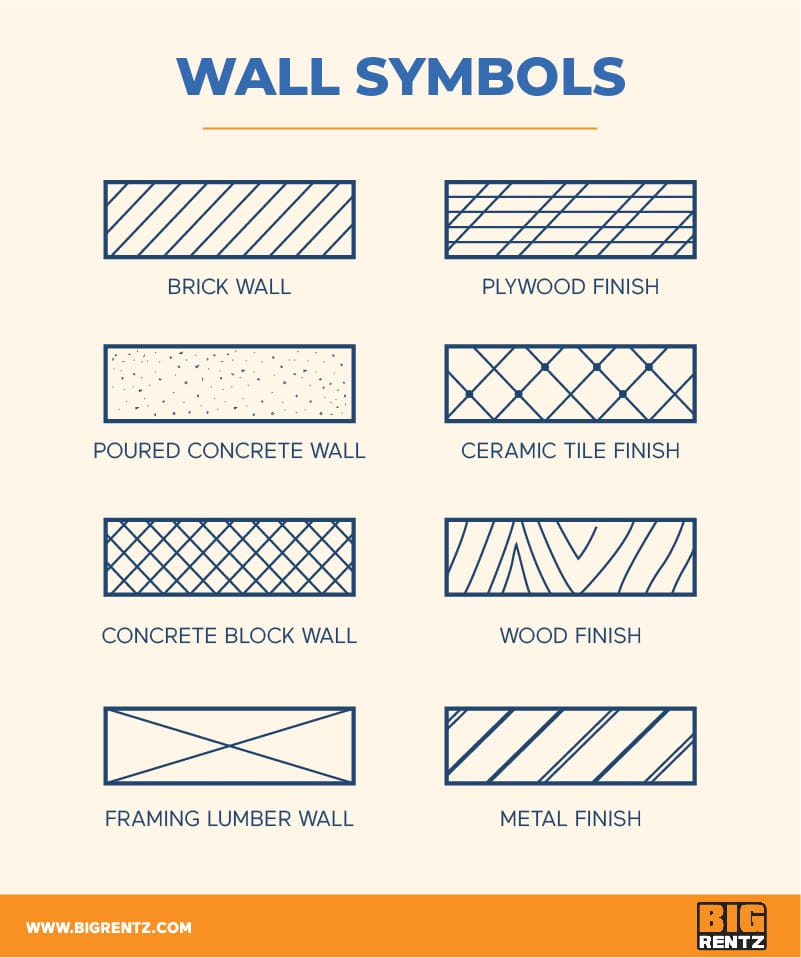Marking Floor Level on a Plan Drawing
When you think of a flooring plan, the first discussion that probably comes to listen is "blueprint." The 2 are related, but they're not exactly the same thing.
A floor plan is one of the construction drawings that y'all'll find included in a prepare of blueprints. They announced aslope site plans, elevation plans, and other detailed working drawings that offering builders a road map for how to build a structure. They serve every bit the cardinal kind of house plan for general contractors and others working in the construction industry.
But just what is a floor plan? And what do nosotros need to know about its symbols?
A flooring plan is a two-dimensional architectural drawing that shows the design of a house or other construction project from above. It is fatigued in what'due south chosen a program view, as if yous're looking down through an invisible roof into the edifice.
Symbols on flooring plans
A floor plan typically shows structural elements such as walls, doors, windows, and stairs, likewise as mechanical equipment for the plumbing, HVAC, and electrical systems.
Floor plans use stylized symbols that often look like the outlines of elements they represent. Tubs, stoves, sinks, and stairs are familiar examples. These tin can appear along with built-in elements of interior design, similar appliances, islands, cabinets, and bookshelves.
Objects and dimensions are also represented on a flooring programme past solid lines or dotted lines of different weights and styles. For examples of the types of lines used on construction drawings, visit How to Read Construction Blueprints.
Floor plan symbols brand upwards their ain language, only as construction workers accept their own vocabulary that they apply to communicate when working on projects. Because it's essential for designers and builders to understand this linguistic communication, a floor programme includes an important element called a legend, which acts as a cardinal that helps viewers translate the drawing.
The legend defines architectural symbols and notations on the program. Many standard symbols appear there for specific projects. Nevertheless, there can be variations in how symbols await and what they represent, which makes consulting the legend essential for each project.
For example, construction companies may apply their own unique blueprint symbols in their gear up of drawings. Also, several unlike-looking symbols may stand for the same item, depending on who you ask. Or one symbol may mean different things to workers with unlike specialties. Ever search the legend on each unique programme to exist clear about what the symbols hateful.
Here are some common symbols y'all're likely to meet in a floor plan.
Door, window, and stairs symbols

Doors and windows are elements establish on every flooring plan, and stairs are almost equally common. Doors appear as gaps in a wall, frequently with an arc showing the fashion the door should swing. Windows are similar, actualization as narrow boxes in walls. Stairs are depicted near ofttimes as a serial of rectangles.
Door symbols

Doors look like larger gaps between walls, frequently with a curved line to show which way the door will swing, indicating clearance. They may await unlike on floor plans depending on their form and part.
- For typical hinged doors that provide entry to a room, the curved line forms a quarter-circle (xc-degree) arc.
- Double doors look similar a stylized letter of the alphabet "M," with two curved lines meeting at the middle.
- A bifold door, often used on a closet, is shown as being open: Information technology looks similar ii peaked tents with a space between them, indicating where they'll run across when closed.
- A pocket door is a sliding door that mostly disappears into the wall when open. A standard sliding door is shown as a thinner line extending from a wider, dark rectangle.
Window symbols

Windows are drawn as office of the walls.
- Regular sliding-glass windows are distinguished from solid walls past three parallel lines.
- Casement windows include arcs similar to those of doors, showing how they open outward.
- Bay windows are angled like the edge of a stop sign, breaking the straight-line trajectory of the wall.
Blueprints include a door and window schedule stating the fashion, size, and material of each.
Stairs symbols

Like the rest of the plan, stairs are seen in a ii-dimensional perspective from above. They look like a series of attached rectangles (commonly) or other geometric forms.
- Some plans may show stairs bisected by a line with an arrow at one terminate to bespeak which direction is up (ascending).
- Landings are shown as larger rectangles or squares.
- A curved or spiral staircase tin can look similar office or all of a wagon bicycle, with wedges joined effectually a curve.
Apparatus and plumbing symbols

In flooring plans depicting kitchens, bathrooms, and laundry rooms, you lot'll come across symbols for appliances like the fridge, stove, washer, and dryer. These commonly appear near plumbing elements similar sinks, showers, toilets, and drains. Symbols can be accompanied by labels or abbreviations that further explicate their functions, or not.
Appliance symbols

Stylized representations of built-in appliances such every bit refrigerators and stove-summit burners are typically included in floor plans.
Simple outlines of appliances with specific hookup sites, such every bit a washer or dryer, are also included. Many are rectangles that surround a letter of the alphabet or ii indicating their function (such as DW for a dishwasher; encounter listing of abbreviations below).
Plumbing symbols

Common plumbing fixtures depicted in floor plans include a toilet, bathtub, and shower, forth with different kinds of sinks: a freestanding sink, single vanity sink, double sink, chiffonier sink, kitchen sink, laundry basin, etc.
Less common fixtures include a bidet or urinal. Associated bathroom features also may be depicted, including towel racks and toilet newspaper dispensers.
HVAC and electric symbols

Since they lie largely inside a edifice's walls, infrastructure elements of the heating, ventilation, and ac (HVAC) systems may be depicted on their own designated sheets within the set of blueprints. Symbols for parts located in the living space or outside the building, such every bit vents or the AC unit, are oft included in the overall floor programme.
Similarly, symbols for internal electrical wiring and mechanisms can crave their own complicated sheets in a set of blueprints. But outlets, switches, congenital-in lights, and other controls accessed in the living space normally announced on the overall floor plan.
HVAC symbols

The HVAC arrangement may be illustrated past symbols for air conditioning units, furnaces, wall vents, ceiling vents, and other ventilation elements. Other HVAC equipment you might find on a floor plan include a pump, heater, render air vent, fan, straight duct, condenser, and Y junction duct.
A heating subcontractor might provide a separate duct and register layout for the HVAC system.
Electrical symbols

You may find a whole host of electrical symbols on a flooring program, showing wall jacks, Tv and switch outlets, thermostats, garbage disposals, and more than. Others include ceiling fans and lights, and flooring outlets.
Electrical symbols often characteristic a subscript — pocket-size writing at the lesser of the symbol — that helps explain the outlet's function or rating. If you see a symbol with a subscript, it should be explained somewhere in the blueprint's legend. (For more than data on abbreviations, meet the section below.)
Wall symbols

Walls are the most common elements of a floor program. Thicker lines represent exterior walls, and thinner lines show interior walls. Sometimes there'due south no visible difference between them. Outside walls also tin can exist depicted by a black outline or double lines rather than a single, solid line.
Different materials may be represented differently on some plans. Walls may exist drawn with hatching or other patterns inside to prove whether they're made of brick, physical, or framing lumber, for case. Outer materials or "finishes" also tin can be shown in this manner, including metal, hardwood, plywood, or ceramic tile.
Flooring program abbreviations
In addition to symbols, floor plans incorporate abbreviations for different elements and materials. These abbreviations can include (but are not limited to) the following:
- Air-conditioning or A/C — Air Conditioner
- B — Basin
- BC — Bookcase
- BV — Butterfly valve
- CAB — Cabinet
- CBD — Cupboard
- CF — Physical floor
- CL — Closet
- CLG — Ceiling
- COL — Cavalcade
- CW — Cavity wall
- CT — Ceramic tile
- D — Door or dryer
- DS — Downspout
- DW — Dishwasher
- EF — Frazzle fan
- FD — Floor drain
- GM — Gas meter
- HTR — Heater
- HW — Hot h2o unit or tank
- KIT — Kitchen
- LIN — Linen closet
- LTG — Lighting
- MSB — Chief switchboard
- O or OV — Oven
- REFRIG or REF — Fridge
- SD — Smoke detector, sliding door, or sewer drain
- SHR — Shower
- WC — Toilet (water cupboard)
- VENT — Ventilator
- VP — Vent pipage
- WIC — Walk-in closet
- W — Window or washer
- WD — Window
- WH — Water heater
- WR — Wardrobe
Deciphering the scale on a floor program

Blueprints for a new abode are commonly shown on newspaper that measures 18×24 or 24×36 inches. Since floor plans demand to fit on a canvas of paper, the drawings must naturally be much smaller than the completed project will be.
The scale of a projection refers to how the measurements on the flooring plans relate to the project's measurements once it's done. It is unremarkably found in or almost the championship block, along with a compass showing the orientation of the home or construction on the building site. (Unlike on maps, the northward arrow does not always point toward the pinnacle of the page, as the front of the structure may face up in a different direction.)
Floor plans are nigh commonly (though not always) fatigued on a 1/4" scale, which means a quarter-inch on the program equals 1 foot of actual length on the completed structure. Some scales use metric instead of imperial measurements.
The scale ensures consistency and helps guarantee that the finished projection will look the mode it was intended — and that it will be structurally sound. The scale applies not only to the exterior walls, but to all elements of the floor plan.
Creating your own floor plans
Flooring plans for a long time were drawn by mitt, and some still are. If yous're interested in creating a floor program this way, you'll need the right equipment: drafting tools such as scales, compasses, cartoon triangles, protractors, and templates.
But these days, dwelling plans are most ofttimes produced digitally. You may need computer-assisted design (CAD) software and, to create prototypes, a iii-D printer.
Software programs such as Microsoft Visio and Floor Plan Creator have templates to get y'all started drafting your dream home. Some provide tutorials to help you larn dwelling house design and floor plan blueprint, and some even offering options for free downloads.
Decision
Flooring plans are like treasure maps drawn by architects and engineers to serve as guides for construction workers — just the landmarks are unlike. Instead of mountains and rivers, you see walls and doorways. Instead of cities and towns, you see stoves and tubs.
In that location's no unmarried "X" that marks the spot where buried treasure lies in a floor plan. Only if you follow the template, y'all'll wind up where you want to exist: with a completed building that'due south non just structurally sound and functional but also comfy and appealing.
Related Posts
Source: https://www.bigrentz.com/blog/floor-plan-symbols
0 Response to "Marking Floor Level on a Plan Drawing"
ارسال یک نظر